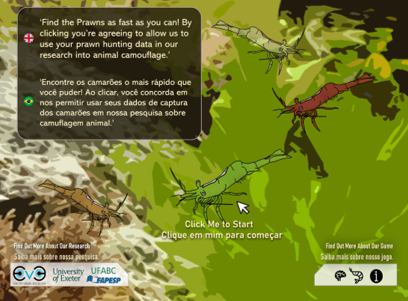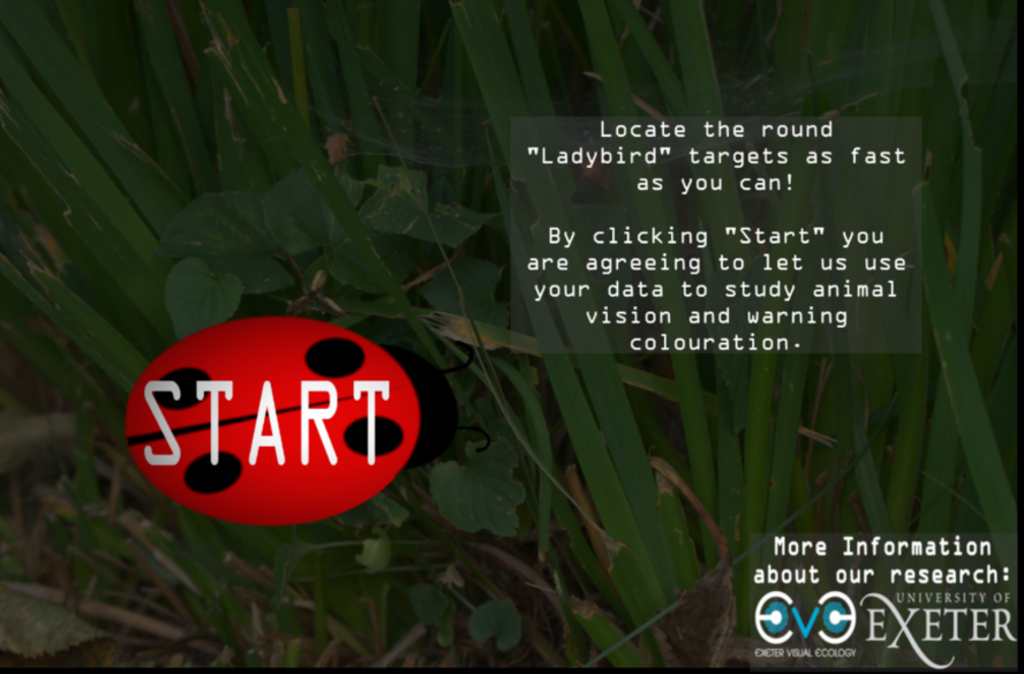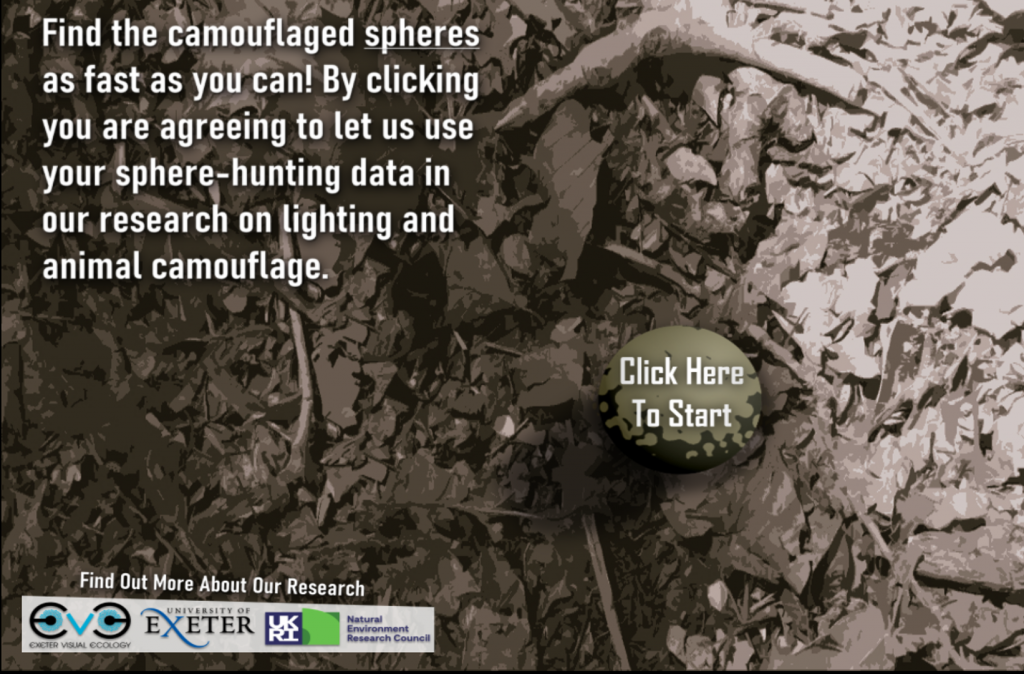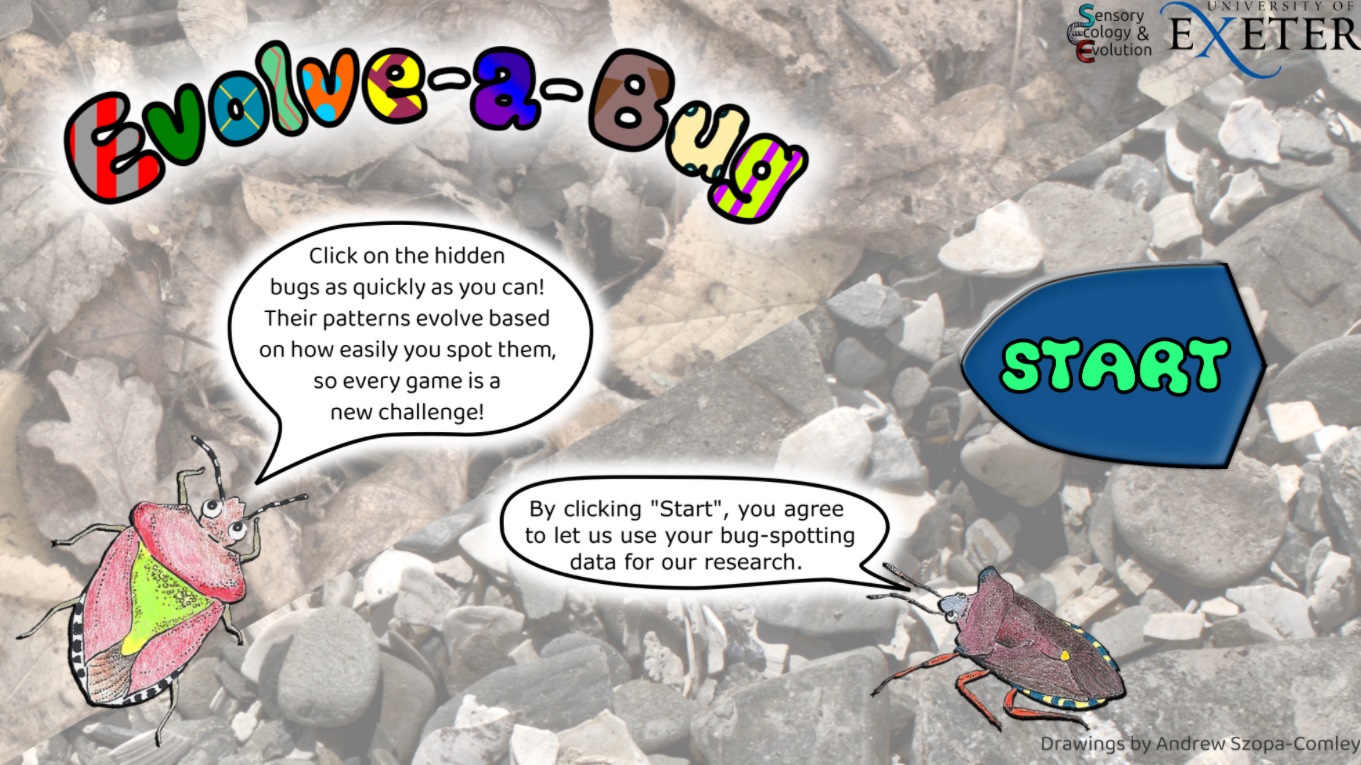We have developed a number of online games which we use for experiments in visual ecology.
Active games are still collecting data for a current project.
Archived games are still playable but are no longer collecting data for an experiment.
Click on the Title to Play.

PrawnGame (Active)
Are the colours and patterns of chameleon prawns adapted to the species of seaweed they live on? Help us understand how different seaweeds can affect the conspicuousness of these vibrant yet camouflaged animals. LAPTOP & PC users only.

LadyBirds (Active)
Are Ladybirds as conspicuous as we think they are? Help us to understand how their patterns might help them stick out in different environments by finding these ladybirds as fast as you can.

Avian Camouflage (Active)
Is the plumage of birds adapted for camouflage in different habitats. Please can you play this game and help us to understand how the avian camouflage matches different habitats. LAPTOP & PC users only.

CamoEvo Online (Archived)
How should animals camouflage themselves in a world that is so variable in colour, structure and lighting? Spots, stripes, green or red? Help us find out in our newest evolution game. Click on targets as fast as you can and take the role of a predator. Patterns that are harder to find get to survive and reproduce producing a new, more camouflaged, generation. Be sure to check back later to see how the camouflage has improved.

Evolving Bugs (Archived)
In our latest game, we’re exploring how prey patterns can evolve to optimise camouflage. Click to find the hidden bugs as quickly as you can, and your performance will shape the colours and patterns of future bugs – the harder it is to find each bug, the more likely their pattern is to survive to play again, while others will change. As the bugs evolve, they should become harder to find, so every new play is a bigger challenge!

Spot the Hares! (Archived)
How can animals living in complex natural environments optimise their camouflage to avoid detection – specialise to match one patch of the habitat really well, or compromise, trying to blend in imperfectly everywhere? Help us find out by searching for these model hares hidden in our Cornish field sites!

Find More Camouflaged Moths! (Archived)
Play the latest version of our moth-hunting game here! We’re investigating how animals in complex and variable habitats can optimise their visual camouflage, to avoid being detected by predators. Which strategy works best – specialising on a particular background, or adopting a more generalised pattern? Help us find out by spotting the camouflaged ‘moth’ triangles as quickly as you can!

Frog Finder (Archived)
Find our sneaky frogs in our latest game investigating camouflage strategies. We are investigating how different types of markings on the bodies of the frogs affect how difficult or easy they are to find.

Find The Camouflaged Moths! (Archived)
Try to find the camouflaged ‘moth’ triangles as quickly as you can and help us to investigate how visual camouflage works! In this game, we are studying whether the moths need to be specialised for a particular background in order to evade capture, or whether a more generalised pattern can sometimes be effective. Happy hunting!

Spot the Plant (Archived)
Camouflage can be found not only in animals, but also in plants. The alpine fritillary lives at extremely high elevations in the screes of southwest China. The colour of this plant varies considerably: some of them are well camouflaged, matching their rock backgrounds. Unfortunately, it is an important member of the traditional medicinal herbs, suffered heavy collection in some areas. By spotting the fritillary in this game, you’re helping us investigate the potential influence of collection on plant colour evolution.

Where is the hare? (Archived)
Snowshoe hares change their coat colour from white in the winter, to brown in the summer. This change in colour enables them to use camouflage to hide from any potential predators all year round. As our planet warms, the time of snow cover is changing and leaving snowshoe hares with extended periods in which their coats do not ‘match’ their surroundings. In this game, play as a coyote or a human hunter to help us examine whether this mismatch will influence the effectiveness of snowshoe hare camouflage.

Crab-hunting Game (Archived)
Green shore crabs are one of the most common crab species found in rock pools around the UK, and are a highly invasive species around the world. The appearance of juvenile crabs varies considerably, and they can even alter their appearance to match their backgrounds. In this game you need to find the photographed crabs as quickly as possible against their natural rock-pool backgrounds, generating valuable data for us on how humans learn to find camouflaged prey.

“Moth” Game (Archived)
The data generated from this game will help us to test a number of different theories related to the “moth’s” camouflage, and how people learn to overcome specific camouflage strategies. The prey take the form of triangles (similar to the shape of moths which often rest on tree bark), with patterns and grey levels that are designed to match their backgrounds. In each game no two moths are alike, which allows us to investigate the general properties of their camouflage and prevents people learning to find one specific moth. We can then assess how the moth’s appearance interacts with its background to influence capture times.

Catch the Crab Game (Archived)
This computer experiment, developed with FoAM Kernow and the Natural History Museum, will aid our understanding of the success of crab camouflage by testing how quickly they are caught by predators with different visual systems, and how animals adapt to different environments. We want to know how camouflaged crabs are to the eyes of predators in different habitats. Play this citizen science game to help us find out.

“Moth” Game (Archived)
The data generated from this game will help us to test a number of different theories related to the “moth’s” camouflage, and how people learn to overcome specific camouflage strategies. The prey take the form of triangles (similar to the shape of moths which often rest on tree bark), with patterns and grey levels that are designed to match their backgrounds. In each game no two moths are alike, which allows us to investigate the general properties of their camouflage and prevents people learning to find one specific moth. We can then assess how the moth’s appearance interacts with its background to influence capture times.

Where is that Nightjar? (Archived)
Nightjars are a master of camouflage. They lay their eggs on the ground and use the camouflage of their own bodies to stop predators seeing them and eating their clutch (not to mention themselves). In this game you can hunt for nightjars using the simulated colour vision of two of their major predators; monkeys or mongooses

Spot the Egg (Archived)
Many birds lay their eggs on the ground and depend on the camouflage of their eggs to protect them from predators. This game shows a number of natural nests we found in Zambia from plovers, coursers and nightjars. You can choose to find the nests using the simulated colour vision of a monkey or a genet. The data generated helps us to investigate the role of colour vision in breaking camouflage.
